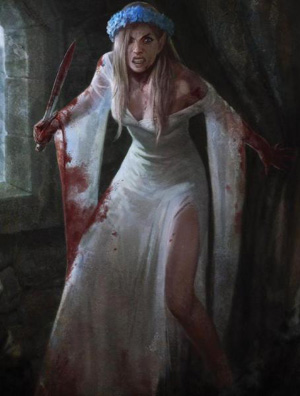Building a New RPG

While BioWare’s Baldur’s Gate and Neverwinter Nights series used Dungeons & Dragons rules and its Forgotten Realms setting, Laidlaw and the rest of the team developed their own system for Dragon Age: Origins. “While we’re huge fans of the D&D license,” he explains, “we felt it was time to take a crack at a fantasy world and rule set of our own. One of the big advantages of developing for consoles and computers is that you can take advantage of the processing power to add things like physics and quick reactions, which are very hard to do in a system designed for sitting around your kitchen table.”
However, the Dragon Age system does use some familiar gameplay mechanics, such as experience and health points and statistical ratings for strength, dexterity, willpower, magic, cunning, and constitution. As in D&D, you choose a race and class for your character and then dole out points to those categories; you increase those scores, as well as the ratings in your class-specific skills, as you advance in levels. Weapons, armor, rings, and other items have minimum requirements for use, so you may need to carry something around for a while before you can take advantage of it.
(If you’re a pen-and-paper role-playing gamer, you may be interested in the tabletop version of Dragon Age.)
“I’m a big fan of rogues backed by strong ‘tank’ warriors and a supporting mage,” Laidlaw says. “A rogue is like a scalpel: they do a lot of damage as long as you put them in the right place. My ideal combats use an isolate-and-conquer strategy: pin as many enemies down as possible, then obliterate them with focused fire.”
Familiar, Yet Different
You have six origin stories to choose from: human noble, city elf, Dalish elf, mage, dwarf commoner, and dwarf noble. There are three base classes — warrior, mage, and rogue — each with four specializations that let you refine your skill set as the game progresses. Any race can be a warrior or rogue, but dwarves can’t wear mage robes because they’re unable to tap into a metaphysical realm called The Fade.
The origin stories offer a wide range of perspectives on the world of Dragon Age. For example, human nobles experience a much different series of events than city elves, who are treated like second-class citizens and forced to live in slums. Dalish elves still freely live in the forests, although they keep to themselves and have splintered into clans that vary widely in their attitudes toward other races and even each other.
“There’s an appeal to fantasy because it is familiar,” Laidlaw says. “A player can dive right into a world of elves and dwarves and know, loosely, what to expect. The artistry of it, though, is to take the familiar and do something unexpected with it.
“Our dwarves are political, cut-throat schemers with rigid caste systems. Our elves have normal lives and have lost most of their culture. Our humans are not held up as paragons of society, and our villains have motivations that go beyond destroying the world.
“Ultimately, we wanted to make a game that was easy to get into because it was familiar and easy to lose yourself in because it was different.”

The Fade was the first realm created by the Maker, who populated it with spirits. Unlike elves and humans, dwarves do not worship any god or gods, which may explain why they can’t access the Fade and are ineligible to become mages. You’ll have a chance to experience the Fade during the game, but if you play as a dwarf, you may find yourself forced into going there. You can also switch control to other members of your party when necessary.
The Fade’s capital was the Golden City, but it became the Black City after the Magisters, magic-wielding leaders of the Tevinter Imperium, entered it; they were seeking a way to usurp the Maker’s power. They turned into the first darkspawn, leading to the First Blight. While darkspawn are always a threat, an invasion by them is not deemed a Blight unless an Archdemon — a slumbering dragon found and tainted by evil — is their leader. The First Blight permanently weakened the Tevinter Imperium, which once ruled nearly all of Thedas, the main continent featured in the game. (Other continents have yet to be revealed.)
The First Blight also led to the creation of the Grey Wardens, and it saw many of the dwarves’ vast underground kingdoms fall to the darkspawn. Four dwarven kingdoms managed to link their military might and hold off the darkspawn, but the demonic creatures took control of the dwarves’ underground Deep Roads and to this day use them to launch attacks against the surface.
Other Blights followed, leading up to the Fifth Blight, which takes place during Dragon Age. It is the first time a Blight has occurred in Ferelden — many citizens don’t believe an actual Blight is happening, since 400 years have passed since the previous one. The Fourth Blight saw so many darkspawn die that it was assumed the menace had been defeated once and for all.
The game is called Dragon Age because the Chantry, a major religious group, divides the Thedas timeline into ages that each last 100 years. Each age receives its name from a major event that occurs shortly before it begins: in the 99th year of the Blessed Age, two powerful dragons went on a rampage, leading Chantry scholars to believe that the next age would be full of strife. You begin the storyline in the 30th year of the Dragon Age.
- Mac OS X version 10.6.2
- Intel Core 2 Duo processor
- 2GB of RAM
- Video card: ATI X1600 or Nvidia 7300 GT or later chipset (Intel GMA950 and X3100 integrated video chipsets not supported)
- 17GB hard disk space
